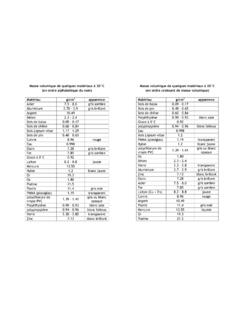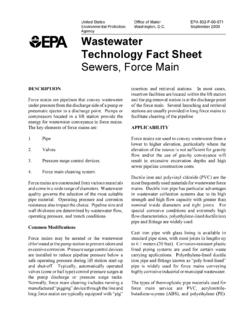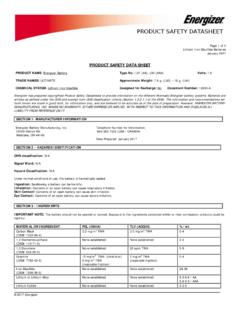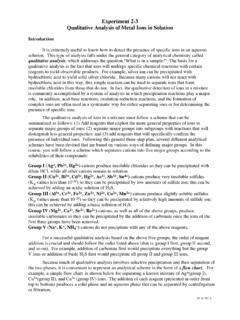Transcription of SOLUBILITY PRODUCT CONSTANTS - Université Laval
1 SOLUBILITY PRODUCT CONSTANTS The SOLUBILITY PRODUCT constant Ksp is a useful parameter for calculating the aqueous SOLUBILITY of sparingly soluble compounds under various conditions. It may be determined by direct measure-ment or calculated from the standard Gibbs energies of formation fG of the species involved at their standard states. Thus if Ksp = [M+]m, [A ]n is the equilibrium constant for the reaction MmAn(s) mM+(aq) + nA (aq),where MmAn is the slightly soluble substance and M+ and A- are the ions produced in solution by the dissociation of MmAn, then the Gibbs energy change is G = m fG (M+,aq) + n fG (A ,aq) fG (MmAn, s)The SOLUBILITY PRODUCT constant is calculated from the equation ln Ksp = G /RTThe first table below gives selected values of Ksp at 25 C.
2 Many of these have been calculated from standard state thermodynamic data in References 1 and 2; other values are taken from publica-tions of the IUPAC SOLUBILITY Data Project (References 3 to 7).The above formulation is not convenient for treating sulfides because the S-2 ion is usually not present in significant concentra-tions (see Reference 8). This is due to the hydrolysis reaction S-2 + H2O HS + OH which is strongly shifted to the right except in very basic solutions. Furthermore, the equilibrium constant for this reaction, which de-pends on the second ionization constant of H2S, is poorly known. Therefore it is more useful in the case of sulfides to define a differ-ent SOLUBILITY PRODUCT Kspa based on the reaction MmSn(s) + 2H+ mM+ + nH2S (aq)Values of Kspa , taken from Reference 8, are given for several sulfides in the auxiliary table following the main table.
3 Additional discus-sion of sulfide equilibria may be found in References 7 and 1. Wagman, D. D., Evans, W. H., Parker, V. B., Schumm, R. H., Halow, I., Bailey, S. M., Churney, K. L., and Nuttall, R. L., The NBS Tables of Chemical Thermodynamic Properties, J. Phys. Chem. Ref. Data, Vol. 11, Suppl. 2, 1982. 2. Garvin, D., Parker, V. B., and White, H. J., CODATA Thermodynamic Tables, Hemisphere, New York, 1987. 3. SOLUBILITY Data Series (53 Volumes), International Union of Pure and Applied Chemistry, Pergamon Press, Oxford, 1979 1992. 4. Clever, H. L., and Johnston, F. J., J. Phys. Chem. Ref. Data, 9, 751, 1980. 5. Marcus, Y., J. Phys. Chem. Ref. Data, 9, 1307, 1980.
4 6. Clever, H. L., Johnson, S. A., and Derrick, M. E., J. Phys. Chem. Ref. Data, 14, 631, 1985. 7. Clever, H. L., Johnson, S. A., and Derrick, M. E., J. Phys. Chem. Ref. Data, 21, 941, 1992. 8. Myers, R. J., J. Chem. Educ., 63, 687, 1986. 9. Licht, S., J. Electrochem. Soc., 135, 2971, 10 21 Barium bromateBa(BrO3) 10 4 Barium 10 9 Barium 10 10 Barium 10 7 Barium hydroxide octahydrateBa(OH)2 10 4 Barium iodateBa(IO3) 10 9 Barium iodate monohydrateBa(IO3)2 10 9 Barium 10 8 Barium nitrateBa(NO3) 10 3 Barium 10 8 Barium 10 10 Barium 10 10 Beryllium hydroxideBe(OH) 10 22 Bismuth 10 10 Bismuth 10 19 Cadmium arsenateCd3(AsO4) 10 33 Cadmium 10 12 Cadmium 10 3 Cadmium hydroxideCd(OH) 10 15 Cadmium iodateCd(IO3) 10 8 Cadmium oxalate trihydrateCdC2O4 10 8 Cadmium phosphateCd3(PO4) 10 33 Calcium carbonate (calcite)
5 10 9 Calcium 10 11 Calcium hydroxideCa(OH) 10 6 CompoundFormulaKspCalcium iodateCa(IO3) 10 6 Calcium iodate hexahydrateCa(IO3)2 10 7 Calcium 10 8 Calcium oxalate monohydrateCaC2O4 10 9 Calcium phosphateCa3(PO4) 10 33 Calcium 10 5 Calcium sulfate dihydrateCaSO4 10 5 Calcium sulfite hemihydrateCaSO3 10 7 Cesium 10 3 Cesium 10 6 Cobalt(II) arsenateCo3(AsO4) 10 29 Cobalt(II) hydroxide (blue)Co(OH) 10 15 Cobalt(II) iodate dihydrateCo(IO3)2 10 2 Cobalt(II) phosphateCo3(PO4) 10 35 Copper(I) 10 9 Copper(I) 10 7 Copper(I) 10 20 Copper(I) 10 12 Copper(I) 10 13 Copper(II) arsenateCu3(AsO4) 10 36 Copper(II) iodate monohydrateCu(IO3)2 10 8 Copper(II) 10 10 Copper(II) phosphateCu3(PO4) 10 37 Europium(III) hydroxideEu(OH) 10 27 Gallium(III) hydroxideGa(OH) 10 36 Iron(II) 10 118-118 Section 1184/30/05 8:47.
6 46 AMCompoundFormulaKspIron(II) 10 6 Iron(II) hydroxideFe(OH) 10 17 Iron(III) hydroxideFe(OH) 10 39 Iron(III) phosphate dihydrateFePO4 10 16 Lanthanum iodateLa(IO3) 10 12 Lead(II) 10 6 Lead(II) 10 14 Lead(II) 10 5 Lead(II) 10 8 Lead(II) hydroxidePb(OH) 10 20 Lead(II) iodatePb(IO3) 10 13 Lead(II) 10 9 Lead(II) 10 7 Lead(II) 10 8 Lithium 10 4 Lithium 10 3 Lithium 10 11 Magnesium 10 6 Magnesium carbonate trihydrateMgCO3 10 6 Magnesium carbonate pentahydrateMgCO3 10 6 Magnesium 10 11 Magnesium hydroxideMg(OH) 10 12 Magnesium oxalate dihydrateMgC2O4 10 6 Magnesium phosphateMg3(PO4) 10 24 Manganese(II) 10 11 Manganese(II) iodateMn(IO3) 10 7 Manganese(II) oxalate dihydrateMnC2O4 10 7 Mercury(I) 10 23 Mercury(I) 10 17 Mercury(I) 10 18 Mercury(I) 10 6 Mercury(I) 10 29 Mercury(I) 10 13 Mercury(I) 10 7 Mercury(I) thiocyanateHg2(SCN) 10 20 Mercury(II) 10 20 Mercury(II) 10 29 Neodymium carbonateNd2(CO3) 10 33 Nickel(II) 10 7 Nickel(II) hydroxideNi(OH) 10 16 Nickel(II) iodateNi(IO3) 10 5 Nickel(II) phosphateNi3(PO4) 10 32 Palladium(II) thiocyanatePd(SCN)
7 10 23 Potassium 10 6 Potassium 10 2 Potassium 10 4 Praseodymium hydroxidePr(OH) 10 24 CompoundFormulaKspRadium iodateRa(IO3) 10 9 Radium 10 11 Rubidium 10 3 Scandium 10 24 Scandium hydroxideSc(OH) 10 31 Silver(I) 10 3 Silver(I) 10 22 Silver(I) 10 5 Silver(I) 10 13 Silver(I) 10 12 Silver(I) 10 10 Silver(I) 10 12 Silver(I) 10 17 Silver(I) 10 8 Silver(I) 10 17 Silver(I) 10 12 Silver(I) 10 17 Silver(I) 10 5 Silver(I) 10 14 Silver(I) 10 12 Strontium arsenateSr3(AsO4) 10 19 Strontium 10 10 Strontium 10 9 Strontium iodateSr(IO3) 10 7 Strontium iodate monohydrateSr(IO3)2 10 7 Strontium iodate hexahydrateSr(IO3)2 10 7 Strontium 10 7 Thallium(I) 10 4 Thallium(I) 10 6 Thallium(I) 10 4 Thallium(I) 10 13 Thallium(I) 10 6 Thallium(I) 10 8 Thallium(I) 10 4 Thallium(III) hydroxideTl(OH) 10 44 Tin(II) hydroxideSn(OH) 10 27 Yttrium carbonateY2(CO3) 10 31 Yttrium 10 21 Yttrium hydroxideY(OH) 10 22 Yttrium iodateY(IO3) 10 10 Zinc arsenateZn3(AsO4) 10 28 Zinc 10 10 Zinc carbonate monohydrateZnCO3 10 11 Zinc 10 2 Zinc hydroxideZn(OH)23 10 17 Zinc iodate dihydrateZn(IO3)
8 2 10 6 Zinc oxalate dihydrateZnC2O4 10 9 Zinc 10 26 Zinc selenite monohydrateZnSeO3 10 7 SOLUBILITY PRODUCT CONSTANTS 8-119 Section 1194/30/05 8:47:47 AMSulfidesCompoundFormulaKspaCadmium sulfideCdS8 10 7 Copper(II) sulfideCuS6 10 16 Iron(II) sulfideFeS6 102 Lead(II) sulfidePbS3 10 7 Manganese(II) sulfide (green)MnS3 107 Mercury(II) sulfide (red)HgS4 10 33 Mercury(II) sulfide (black)HgS2 10 32 Silver(I) sulfideAg2S6 10 30 Tin(II) sulfideSnS1 10 5 Zinc sulfide (sphalerite)ZnS2 10 4 Zinc sulfide (wurtzite)ZnS3 10 28-120 SOLUBILITY PRODUCT CONSTANTS Section 1204/30/05 8:47:47 AM







